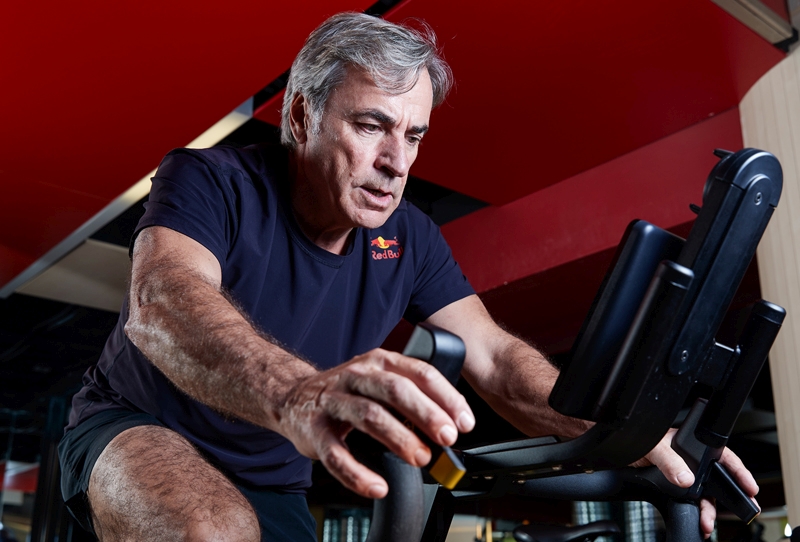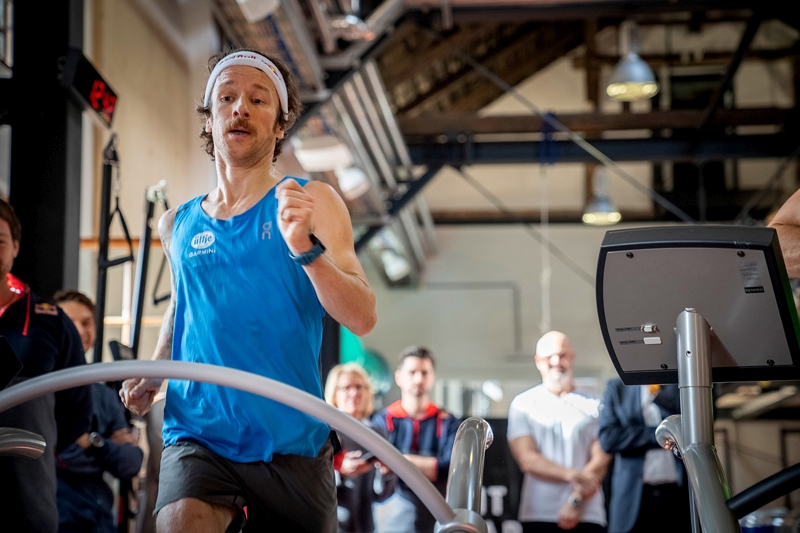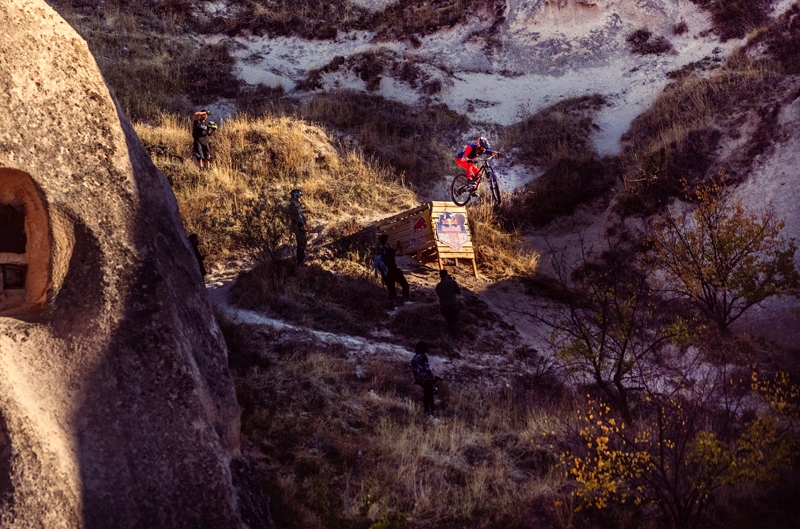You are viewing 1 of your 1 free articles. For unlimited access take a risk-free trial
Training for gains: RISE and shine for optimum benefits?

SPB looks at some new data on how your biological sex and the timing of your training can affect the benefits it delivers
While many athletes train to solely improve sports-specific performance, there are many others for whom the fitness and health gains delivered also play an important motivating factor. Indeed, research shows that athletes are increasingly following training regimes that focus on healthy lifestyle routines, and which are multi-faceted in nature - ie include a combination of resistance training, high intensity intervals, stretching/flexibility, and steady-state endurance training(1). This is perhaps not surprising; when it comes to metabolic health and weight management benefits, training programs which combine resistance and endurance exercises are known to be more effective in improving body composition than either training type carried out alone(2,3).The RISE protocol
One particular training program that is time-efficient and practical, and which has been shown to give excellent gains in cardiovascular health, body composition, fitness and functional strength is the ‘RISE’ protocol. The RISE protocol is a multimodal exercise program (sometimes combined with carefully timed whey protein feeding – then dubbed ‘PRISE’) with well-documented efficiency in both trained men and women(4-6). Typically the a RISE protocol involves a multi-faceted approach of resistance/functional exercise (R), interval-type sprint exercise (I), stretching (eg yoga Pilates etc - S) and endurance (E) exercise.Although the RISE protocol has been relatively well studied, research is underway to see how it can be optimized to produce maximum gains for the time invested. In particular, there are two areas where more data would be beneficial: 1) Do men and women respond differently to this protocol, and if so how? 2) Does the time of day of training affect the benefits that RISE training produces and if so, does it affect men and women equally? As SPB readers will know from previous articles, the circadian rhythm has a profound effect on physical performance, with key aspects of muscle function during exercise changing according to the time of day(7). However, it also turns out that the time of day you train (exercise time of day – ETOD) can affect the training adaptations that occur following training(8).
New research
To try and answer these questions, a team of US researchers has investigated the training benefits of a RISE program in both men and women, and conducted at different times of the day (ETODs) and their findings have just been published in the journal ‘Frontiers in Physiology’(9).In this study, 30 trained women (average BMI 24kg/m2) and 26 trained men (average BMI 25kg/m2) were recruited to the study. Although the participants were not especially lean in the athletic sense, they were all highly active, training at least four days per week for more than 30 minutes per session and had been so for least three years beforehand. In addition, they were all ‘weight stable’ and had been for at least six months prior to the study. These participation criteria were considered important as any improvements following the RISE intervention performed at different times of the day would suggest additional benefits above and beyond the participants’ existing training regime.

All the participants followed the same 12-week RISE program with the same relative volume and intensity. However before the 12-week training period began, they were randomized to two different ETODs:
- Training in the morning (06.00–08.00am)
- Training in the evening (18.30–20.30pm)
- Resistance exercise (R)
- Interval sprints (I)
- Stretching/yoga/Pilates (S)
- Endurance exercise (E)
- The resistance training routine was comprised of a dynamic warm-up, lower and upper body resistance, followed by core muscle movements performed for 10-15 repetitions and for two to three sets, in order to induce muscular fatigue. A 30–60 second recovery was allowed between sets of the same exercise and between different types of exercises.
- The sprint interval training sessions were comprised of 7–10 sets of 30–60 seconds of near maximal all-out sprints with 2–4 min of recovery/rest in between sets, such that the entire routine was completed within 35 minutes. Participants were free to choose any mode of exercise (treadmill, elliptical, stationary bike, swimming, snowshoeing, cycling, rollerblading, etc.) to complete the sprints.
- The stretching exercise routines were led by a certified yoga instructor and utilized a combination of familiar stretching and traditional yoga poses, as well as several additional Pilates movements such that all the major muscles and joints of the body were involved.
- Lastly, endurance exercise training included full body, rhythmical aerobic activities such as running, cycling, rowing, swimming, ellipticals, etc. and was performed for 60+ minutes at 60% of maximal effort based on the heart rate reserve formula.
Box 1: Meal timings in the RISE intervention study
The timing of meals was an important component of the current study. On resistance (R) and interval (I) exercise training days, participants consumed a small snack (containing around 250–300 kcals) 1 hour beforehand. On stretching (S) and endurance (E) training days, they arrived fasted (for morning sessions, fasting was overnight and in PM session, fasting was for four hours beforehand) but well-hydrated and were allowed to consume water/electrolyte beverages as needed.Participants in AM exercise, consumed breakfast after their exercise routine and remaining meals were consumed at approximately 4-hour intervals throughout the remainder of the day. For PM exercise participants, starting with breakfast and every 4 hours, three meals were consumed prior to their exercise routines with the fourth meal consumed within an hour of finishing their evening exercise. On non-exercise days, participants consumed breakfast within an hour of waking in the morning and remaining meals were consumed every 4 hours thereafter, with the final evening meal consumed within 2 hours of going to bed. Importantly, both the AM and PM groups were provided equivalent nutritional support, as well as total calorie and macronutrient distributions throughout the 12-week intervention.
Before and after the program, all the participants underwent comprehensive testing and assessment. Parameters that were tested included muscular strength (1-rep bench/leg press), muscular endurance (sit-ups/push-ups) and power (squat jumps bench throws), aerobic capacity and time-trial performance (on a stationary bike), body composition (using the highly accurate DXA technique), fat mass, abdominal fat, systolic/diastolic blood pressure (BP), respiratory exchange ratio (RER), profile of mood states (POMS), and dietary intake were assessed.
What they found
A huge amount of data was collected, which for the sake of clarity and brevity, we won’t duplicate in full here. However, the detailed findings on the physical performance and body composition changes between AM vs. PM exercisers during the 12-weeks intervention can be found in table 3 of the study here. Likewise, detailed cardiovascular and metabolic health indicators can be found in table 4 of the study. However, the key findings to emerge from the data showed that men and women responded differently to the time of day they trained, and can be summarized as follows:Women
- In the women cohort, those who exercised in the AM had greater reductions in total (−5% vs. −2%) and abdominal fat mass (−10% vs. −3%)
- Likewise women training in the AM period experienced a larger drop in blood pressure (−10% vs. −3%), as well as increased lower body muscle power (13% vs. 4%).
- By contrast, women exercising in the PM had significantly greater gains in upper body muscle strength (16% vs. 9%), power (37% vs. 8%), and endurance (40% vs. 25%).
- Women exercising in the PM also showed a tendency to experience improved mood and greater satiety (ie less hunger cravings) than when they trained in the morning.
- In the men cohort, the responses to AM and PM training were rather more similar compared to the women (but there were differences nevertheless).
- Men training in the PM experienced a significantly greater reduction in systolic blood pressure (−12% vs. −3%) compared to morning training.
- Men training in the PM also benefitted from increased fat oxidation (6% vs. 1%) compared to AM exercisers and experienced significantly less fatigue.
In summary
The authors concluded that when following a RISE-type training program, women and men respond differently to exercise time of day in terms of the benefits gained. Therefore, for those that can, choosing the time of day to train could yield a distinct advantage. If you are male, the health and fat burning benefits are greater if you train late afternoon/early evening compared to morning training, and you’ll likely experience less fatigue too. In a nutshell, this study suggests training in the evening is better hands down!For women, the recommendations are less clear cut. If it’s mainly fat loss or weight management you want, or greater lower body strength, morning training is your best bet. For upper body strength and power, or for the greatest endurance gains, evening training appears to be better. Evening training will also likely produce a greater mood lift and reduce the food craving cravings compared to morning training!
References
- Sci. Sports Exerc. 2011; 43, 1334–1359
- J. Prev. Cardiol. 2012; 19, 81–94
- Aging Clin. Exp. Res. 2015; 27, 179–186
- Growth Hormone IGF Res. 2017; 32, 60–70
- Nutr. Metab. 2015, 715859
- ‘The PRISE 3 Study’. Nutrients 2016; 8, 332
- BMJ Open Sport Exerc Med. 2021; 7, e000876
- Metab. 2019; 30, 92–110. e114
- Front Physiol. 2022; 13: 893783. doi: 10.3389/fphys.2022.893783
Newsletter Sign Up
Testimonials
Dr. Alexandra Fandetti-Robin, Back & Body Chiropractic
Elspeth Cowell MSCh DpodM SRCh HCPC reg
William Hunter, Nuffield Health
Newsletter Sign Up
Coaches Testimonials
Dr. Alexandra Fandetti-Robin, Back & Body Chiropractic
Elspeth Cowell MSCh DpodM SRCh HCPC reg
William Hunter, Nuffield Health
Keep up with latest sports science research and apply it to maximize performance
Today you have the chance to join a group of athletes, and sports coaches/trainers who all have something special in common...
They use the latest research to improve performance for themselves and their clients - both athletes and sports teams - with help from global specialists in the fields of sports science, sports medicine and sports psychology.
They do this by reading Sports Performance Bulletin, an easy-to-digest but serious-minded journal dedicated to high performance sports. SPB offers a wealth of information and insight into the latest research, in an easily-accessible and understood format, along with a wealth of practical recommendations.
*includes 3 coaching manuals
Get Inspired
All the latest techniques and approaches
Sports Performance Bulletin helps dedicated endurance athletes improve their performance. Sense-checking the latest sports science research, and sourcing evidence and case studies to support findings, Sports Performance Bulletin turns proven insights into easily digestible practical advice. Supporting athletes, coaches and professionals who wish to ensure their guidance and programmes are kept right up to date and based on credible science.











